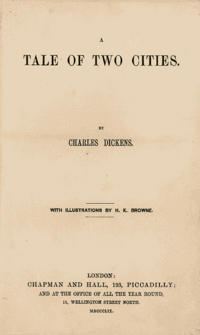One of the most brutal revolutions in Europe in recent times has been the French Revolution; it had many phases and can be taken to mean the period between 1789 and 1799, when the army finally took over in the form of its leader, Napoleon Bonaparte. In the interim period, there were many struggles, many twists and turns. A new instrument of murder, the guillotine, was the main execution tool. People condemned to death for anti-revolution fervor, for their thoughts, and because getting them condemned to death removed them from the scene, all would be brought to the public squares where they would be executed with the guillotine.
'A tale of 2 cities' was published in 1859, and is set during the time period of the French Revolution. It shows the sheer terror of those times, where you could be condemned to death for even sympathizing with the fate of an earlier executed 'enemy' of the revolution, where a person could be condemned based on the written statement of a person (even if the person wants to take the statement back). The terror of the French Revolution evolved during a complex stage in which the excesses of the nobility and the church had crushed the poorer part of the population (Wikipedia), and this was almost pay-back time. 
The book led to a very remembered opening statement, starting with these incredible words, "It was the best of times, it was the worst of times, it was the age of wisdom, it was the age of foolishness". The book covers the conflicting story of many people, including arrogant aristocrats who were condemned, humble and good aristocrats who were also condemned, people taking revenge using the medium of the revolution, and how the revolution eventually also condemns those who were its proponents earlier. The book has been used as the base for a number of movies over the years, and was itself based on the book 'The French Revolution: A History' by Thomas Carlyle.
The novel covers the story of the following main characters:
- Dr Alexandre Manette: A prisoner in the Bastille for 18 years, and the father of the lady who is one of the main characters
- Lucie Manette: Young lady loved by both Charles Darnay and Sydney Carton, and also the daughter of Dr. Manette
- Charles Darnay: A young, and good-natured French nobel. He never liked the cruelty of his family towards the peasantry and abandons the family name (Evrémonde), and fled to England after assuming his mother's maiden name
- Sydney Carton: A complex, but depressed English barrister. Loves Lucie, and promises her that he will do whatever he can for her and her family. Eventually does so in the end with a supreme act of self-sacrifice.
- Monsieur Ernest Defarge: Took care of Dr. Manette, also a closet revolutionary
- Madame Therese Defarge: A dark-natured closet revolutionary and wife of Ernest. She is also bent of taking revenge for the extermination of her family at the hands of Darnay's uncle
Year in Review 2017
6 years ago
No comments:
Post a Comment